Prairie Dunes Country Club
KS, USA
Green Keeper: Cory Griess
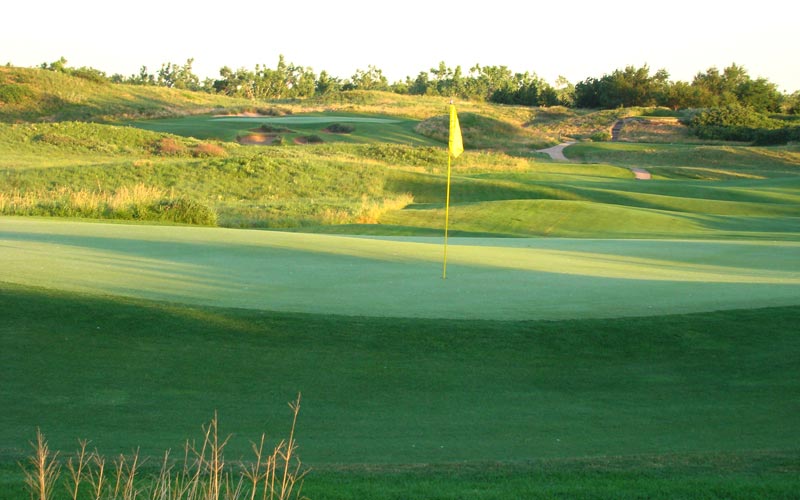
Though Perry Maxwell built the majority of the holes on the front nine and…
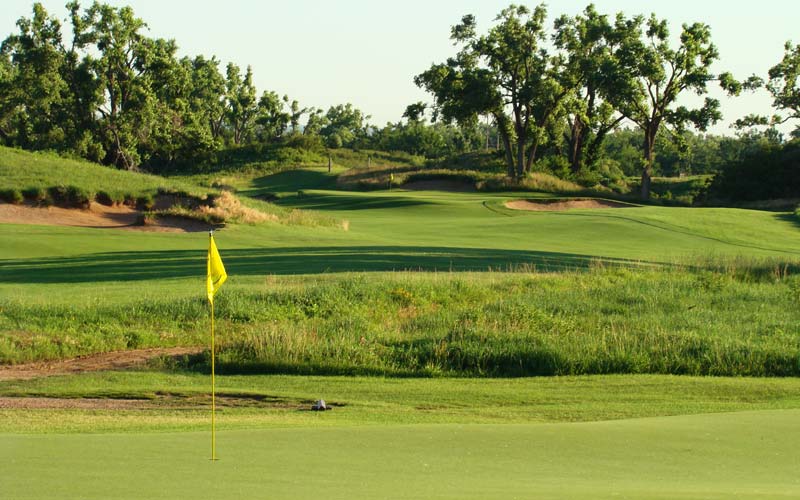
…his son Press built the majority of the holes on the back nearly twenty years later, the two nines come together seamlessly and offer something with which few links can compete: not a single indifferent or weak hole.
Prairie Dunes enjoys a colossal reputation in the world of golf and yet, curiously, not but so many people make the trek to Hutchinson, Kansas to see the course. They know that the wind, humpy-bumpy fairways, plum thicket and firm playing conditions make it play akin to the great links in the United Kingdom. But, unlike in the U.K., where for instance, Turnberry, Prestwick, Royal Troon, and Western Gailes are in a cluster, Prairie Dunes stands alone. Also, too, they reason that a visitor must be accompanied by a member as is the typical policy at leading private clubs in the United States.
In this last regard, Prairie Dunes is more like a British club whereby a proper Letter of Introduction can help a visitor gain access to the course at certain times through the week. In short, the good people here in the Midwest believe in sharing, which effectively makes Prairie Dunes the very definition of a national treasure. And given the ease of travel and the Wichita airport being readily accessible, there is simply no reason that any student of the game doesn’t beat a path to play this course.
The best way to convince someone of the merit in doing so is simply to showcase each hole because they are individually of such a uniformly high standard that no architectural education is complete without studying them. One reason that the Maxwells achieved so much here is that Perry was instrumental in selecting this location. Initially, another parcel of land was being considered but Perry convinced the founders of the merits of today’s prairie site with its random dunes. Once this exceptional property was secured, Perry knew exactly what to do, as we see below!
Scorecard of the Course
(side note: While Perry Maxwell routed eighteen holes in 1937, the Carey family elected to open only nine holes prior to WWII, and in general, they were the holes closest to the clubhouse. Four years after Perry’s death, his son James Press Maxwell completed the job in 1956. As Perry Maxwell’s original eighteen hole routing plan may not exist (like Pete Dye, one can imagine him saying ‘Plan? Why do I need plans? I’m always there!’), the question arises as to whether Press Maxwell followed his father routing and/or whether he perhaps found some of the holes himself. Regardless of who routed what, the man who built each hole is noted below).
First hole, 430yards, Carey Lane, (Perry); Though the diagonal angle off the tee makes it a first rate driving hole, the golfer is confronted with one of the primary design tenets that the Golden Age architects followed: Defend par at the green. In this case, the green starts as an extension of the fairway before rising to form a back right bowl. The hole remains a delight to play regardless of wind direction thanks to its open green front coupled with the firm and fast playing conditions through the green. Helping to insure that the course plays just right, the club has formed a long standing relationship with the firm of Coore & Crenshaw. In fact, even before there was a Coore & Crenshaw, Bill Coore did work here in 1984. Thus, for nearly twenty-five years, he has helped oversee that the mowing lines, bunkers, green contours and green sizes remain faithful to the Maxwells’ shared vision.
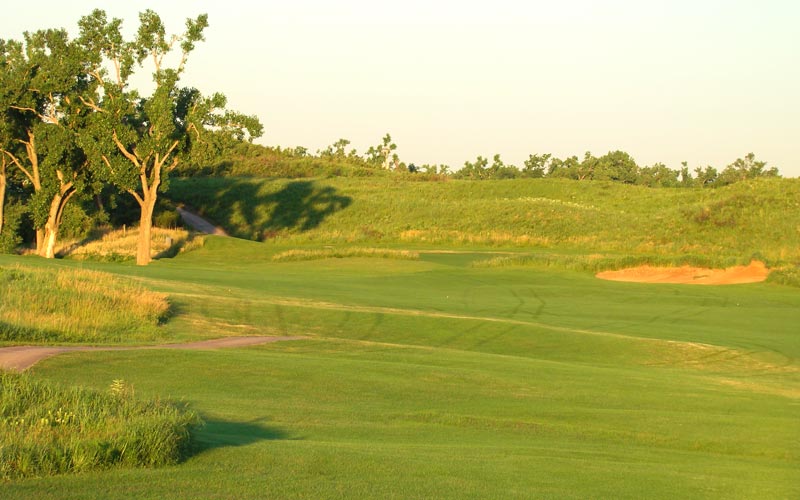
Just the sight of such a hole makes one want to rush directly from the car and onto the first tee. The ideal tee ball is at the far bunker with a draw.
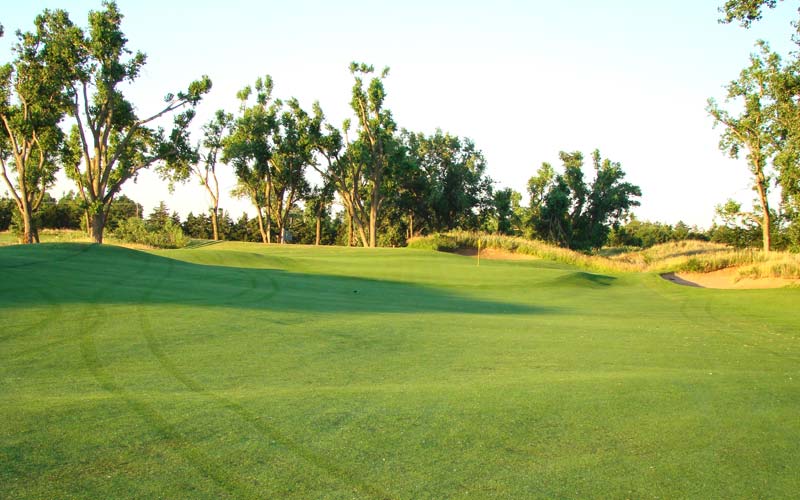
The beauty of some of the greens at Prairie Dunes is that they sometimes appear to not offer a single hole location, such is the continual random movement found within them! Here at the first, lower hole locations are easier to access as the two foot rise in the green can be used as a backboard.
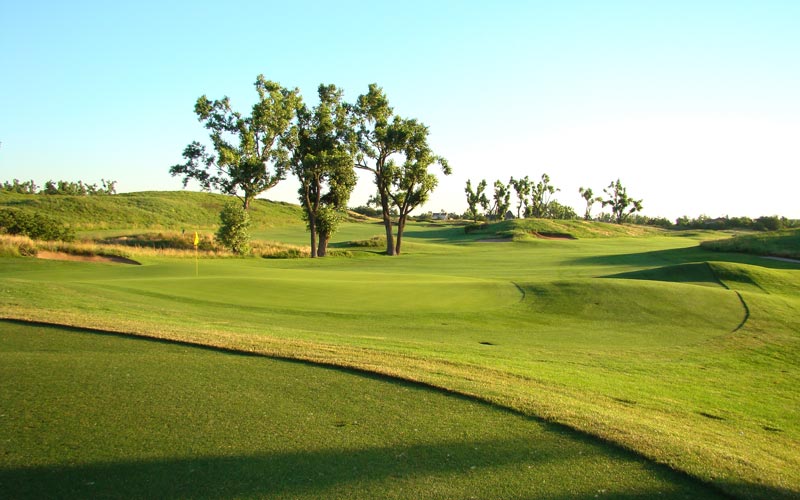
Prior to 2005, as is conventional at most inland courses, rough typically ringed the back and sides of the greens. However, the green complexes here are too good to be covered up in such a manner. Thus, Coore & Crenshaw worked closely with the club to devise a plan to dramatically increase the amount of short grass around the greens. Once completed, all golfers, no matter what their skill level, delighted in the additional short game recovery options. The extra six paces of short grass around the first green is evident in this view looking back down the hole.
Second hole, 160 yards, Willow,(Perry Maxwell); The twelfth green at Augusta National is famous for its diagonal angle that makes the player first determine his line and then select his club. Perry was performing consulting work at Augusta National the same year that the first nine holes opened at Prairie Dunes and it seems likely to the author that the strategic merit of the twelfth was fresh in his mind as he built the second here (albeit with the second running from front right to back left). Deep bunker guards the front and yet to go over the green is worse. Unlike the twelfth at Augusta National, the putting surface is full of character and undulations. When the 2002 U.S. Women’s Open and the 2004 U.S. Senior Open were held here, the contestants wisely treated it with the same respect/fear as the twelfth at Augusta.
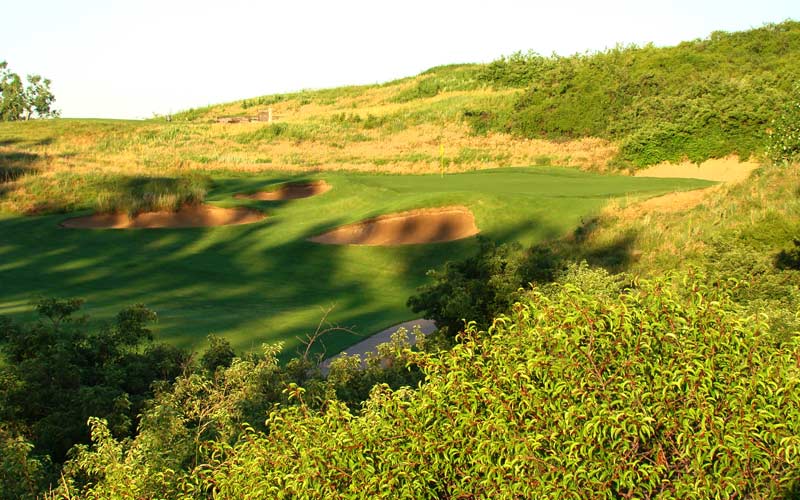
The second green is set on a diagonal from the tee.

Believe it or not, missing the green in the front bunkers beats going long.

Green speeds have increased upwards of 30% since the course first opened for play. As such, sometimes the slopes within the greens have required attention. At the second, the dune had started to encroach from the right and Coore needed to ever so slightly lower the green’s back right to preserve that original hole location. Regardless, the green still features a fearsome amount of back to front tilt at today’s green speeds.
Thirdhole, 355 yards, Wild Plum,(Press Maxwell); Thanks to the long time former Green Keeper Doug Petersan, the back markers were relocated in the 1970s to the highest spot on the course atop the sand dune that dominates the front nine. As such, the golfer is exposed to the full effects of the prairie winds, which can change the hole from a three wood/flip wedge in the morning to a driver/punch five iron in the afternoon. Importantly, Petersan created a strategically appealing diagonal carry over the plum thicket when he moved the back markers up and to the left from the original Press Maxwell teeing area.

Hustling up to play the back markers on the elevated third tee. Note the natural sandy soil into which the wooden steps were set.
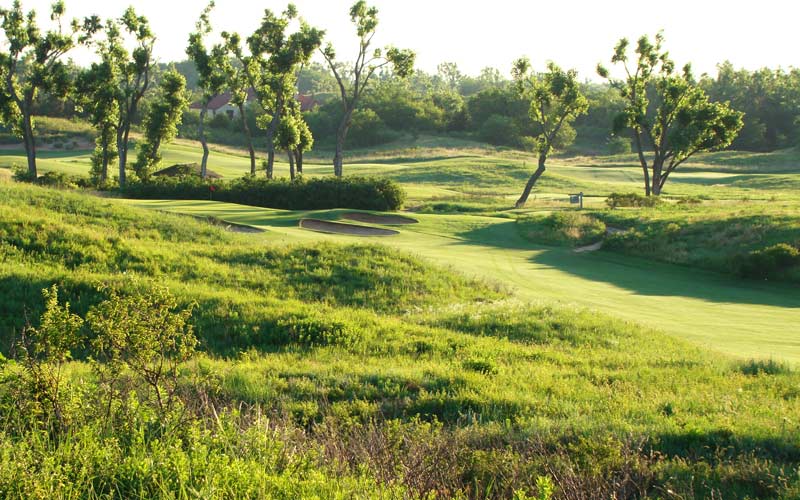
The tee ball from high atop the dune at the third can be unnerving, especially when the wind is up. The question always posed is how much of the plum thicket does the golfer dare carry.
Fourth hole, 170 yards, Hill Top(Press Maxwell); As at the second hole, the green is superbly situated on a shelf with menacing bunkers cut out from the dune. While the second green provides the opportunity for more four (!) putts, the fourth hole lays longer as the green is well above the golfer on the tee. As such, the ball is in the air longer, creating more time for drama to unfold as the wind grabs it and does mean things. If anything, the back bunker just left of the putting surface that was added by Coore & Crenshaw in 2006 is a mercy one as it helps a pull or a draw stay out of the gunch.
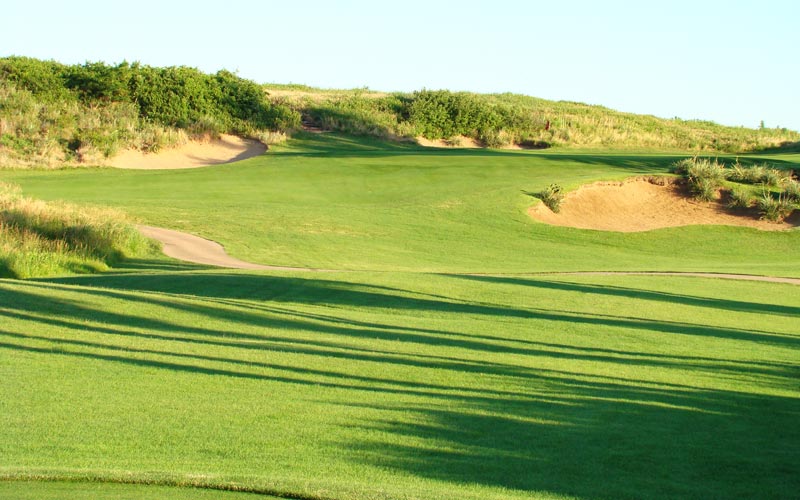
A perfectly conceived green complex – the fourth at Prairie Dunes. Tee balls hit directly at the day’s hole location (the red flag is in the early morning shadow) need to be up or the short grass can send the ball well back down the slope. When the hole location is moved right and behind the two deep bunkers, a different set of problems confront the golfer.
Fifth hole, 440 yards, Quail Ridge,(Press Maxwell); The golfer needs to play this hole as it is laid before him, which is to say straightaway. Any approach angle becomes progressively worse other than from the right center of the fairway. Generally, this hole plays into the wind and as such requires a controlled long iron approach held underneath the wind. And yet, downwind the hole may even be harder as the golfer must use the bank in front of the green to brake his approach shot.
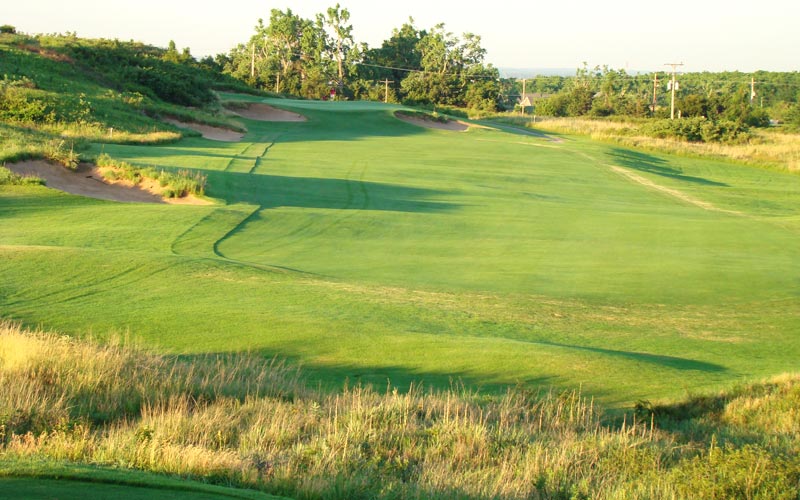
A drive at the right greenside bunker will keep all approach options open to the golfer.
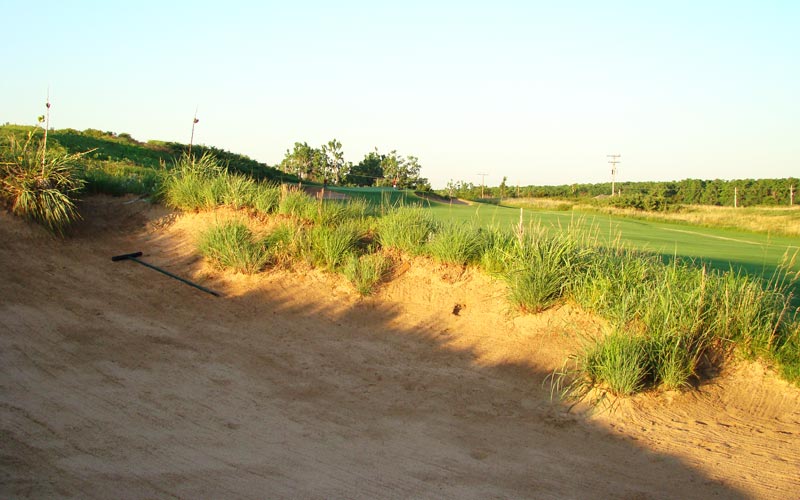
Best to avoid the left side of the fifth hole altogether.
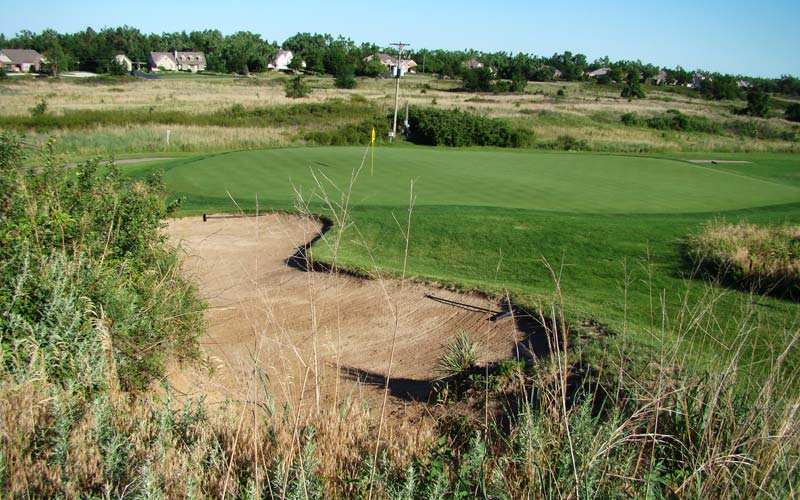
A view from the sixth tee back at the fifth green indicates how much longer the green is than wide, which highlights the need for attacking the green head on. Note the two Press ‘puffs’ within the green that make this hole location particularly challenging. The short walk from green to tee shows why the course is a walker’s delight.
Sixth hole, 390 yards, Cedar, (Perry); When Perry Maxwell’s nine holes opened for play in 1937, golfers headed to this tee from the second green and played this as their third hole. Great use of natural landforms abound and the accomplished golfer likes to hit a draw down the right of this fairway to a) get a sling forward off its high right side and b) to open up a view of the putting surface that is otherwise obscured from the left by a large bunker short of the green. Many a golfer upon approaching the green complex is disappointed/perplexed to find his ball in the swale between the short front bunker and the green. The resulting recovery shot can be played with a three wood to a flop wedge to a putter.

The exhilarating view from the elevated sixth tee shows the fairway as it swings left around the bunker on the inside of the dogleg. Rather than flirt with the bunker, the golfer can use the right to left slope of the fairway on the outside of the dogleg to his advantage.
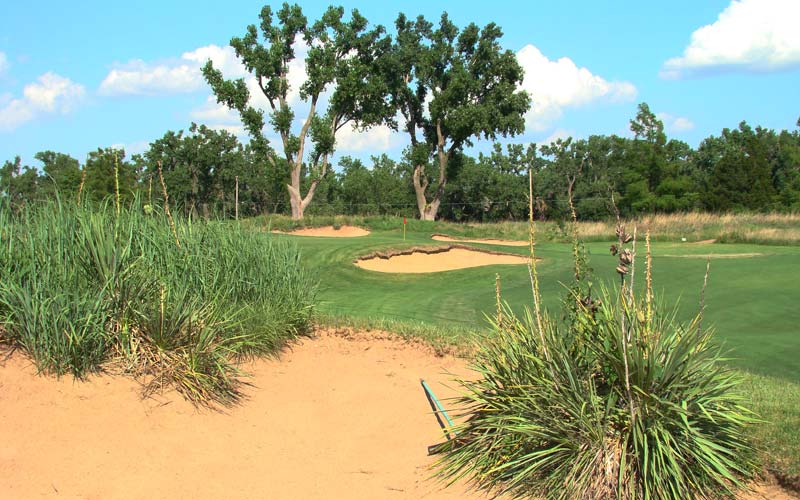
The unfortunate golfer who finds this inside left bunker off the tee faces a 135 yard shot to the green. The large bunker in the distance is a full twenty paces from the green and creates depth perception problems.
Seventh hole, 510 yards, South Wind, (Perry); When the hole lives up to its name South Wind, a good drive can ride the wind and catch the down slope in the fairway, leaving the golfer with a mid-iron into this par five. However, the target is a tight one as the green is sandwiched between two hummocks with sand and tall grass all around. Conversely, when a front is moving through, and the opposite wind is blowing, this can be one of the most demanding holes on the course.
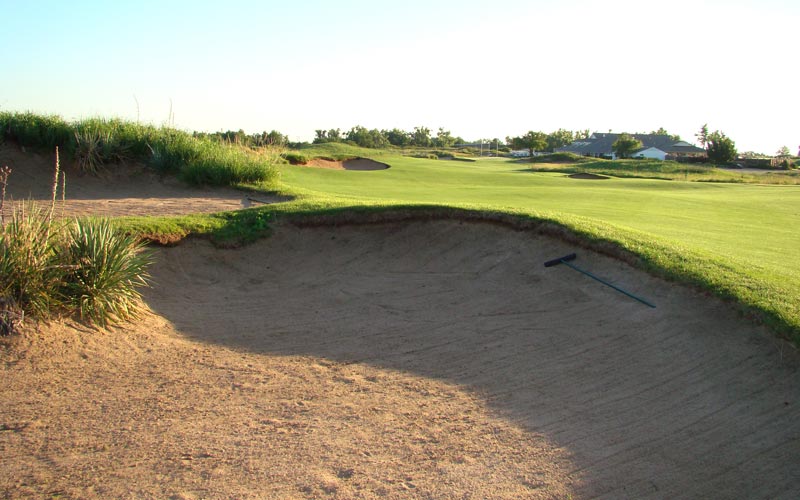
The two bunkers in the foreground were built by Perry Maxwell but at 215 yards from the back tees, they are only in play when a strong wind is dead against. Thus, Coore cut a bunker into a natural landform some seventy yards ahead to help the hole preserve Maxwell’s original challenge.
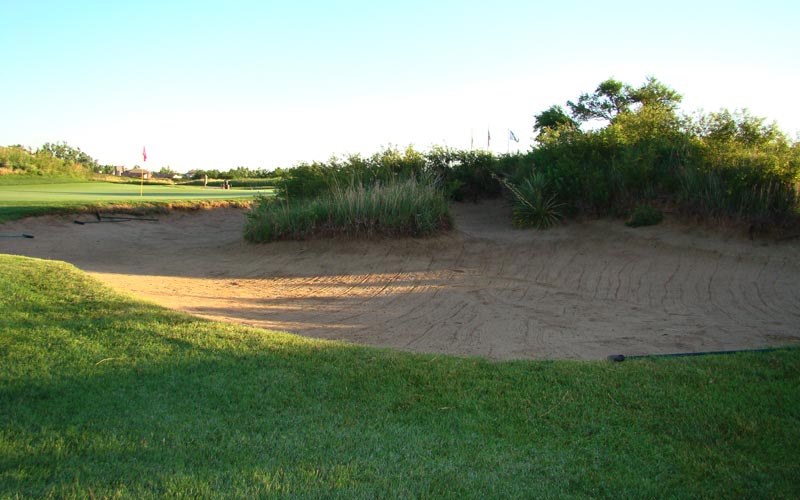
Though a reachable par five, great care needs to be taken with one’s approach as golfers going for the green in two have walked away with doubles and worse, such is the penalty that the thick vegetation doles out.
Eighthhole, 430 yards, Dunes, (Perry); The fact that this famous hole needs no fairway bunkers speaks as to its wildly rolling topography. Indeed, when Coore first walked the property in 1984 with then Green Keeper Doug Petersan, he remarked that he had never seen land better suited for golf. Petersan, ironically as it turns out, replied that he knew where there was land of comparable quality and that was in the sand hills of Nebraska. Of course, over a decade later, Coore would be found working there but he is the first to point out that Prairie Dunes set the stage for all future prairie courses. Not content with just the difficult tee to green aspect of the eighth, Perry Maxwell built what is possibly the course’s most severe green with four feet (!) of elevation change from back to front and a ridge through its back middle. Having only taken the game up at the late age of thirty-five, Perry became famous for working on some of finest greens in the country including those at National Golf Links of America and Pine Valley. Of all his work, no single green is any more impressive than the one here.
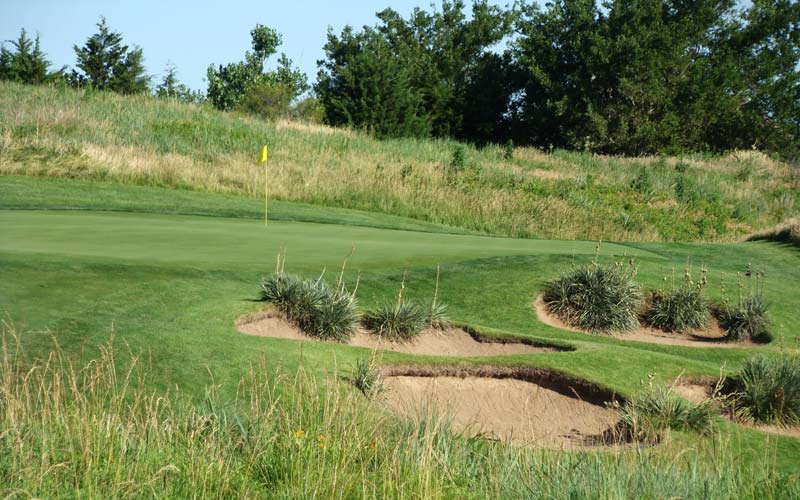
This view of the eighth green is from the crest of a hill 150 yards from the green. This same hill insures that most approaches are semi-blind or blind and the golfer rarely has a good look at the flag.
Ninth hole, 450 yards, Meadow Lark (Perry); The fairway contours at Prairie Dunes are the near equal to the ‘Maxwell rolls’, a term famously associated with Perry Maxwell’s green contours. And nowhere are these contours better highlighted than in the ninth fairway. According to the yardage book, Maxwell used a team of mules pulling fresno scrapers to move the earth. Though a slow and laborious process, the end result can be seen with this rippling fairway. The invariably uneven stance contributes much to the hole’s natural defenses.

This view from the tee highlights the character of the ninth fairway.

The two to four feet folds in the ninth fairway are perfect for golf and remind some of the crumpled fairways at St. Andrews. Sadly, modern earth moving equipment has a way of snuffing out such character, which is one reason why few (if any) modern designs are as engaging to play on a regular basis as Prairie Dunes.
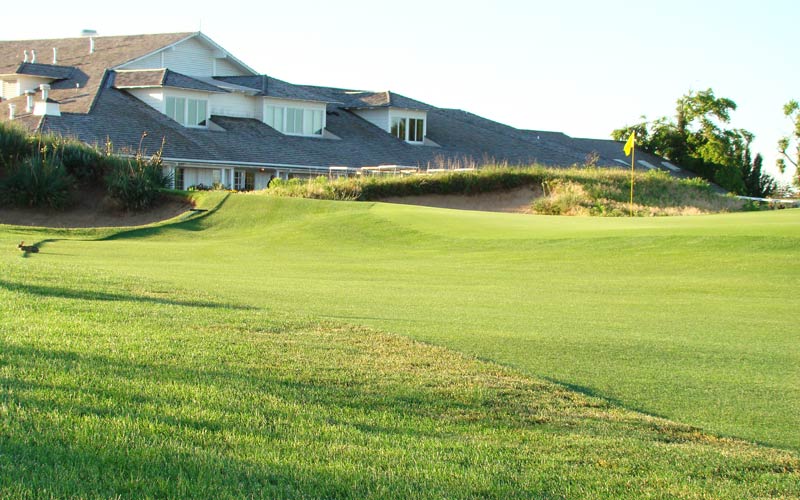
This tightly mown area was rough in 2005, leaving the golfer reaching for his wedge as his one recovery option. Now, golfers are free to select from one of several type recovery shots.
Tenth hole, 185 yards, Yucca, (Perry); Is there any course whose first three one shotters are as good as the ones at Prairie Dunes? Perhaps Pine Valley given its diversity of length but no other course readily springs to mind unless one was to cheat and pick the Composite course at Royal Melbourne. This is an important fact because if one is coming this far to play one golf course,the golfer needs to be treated to holes of great exception – and Prairie Dunes possesses them like few other courses. When the Mid-Amateur was contested here in 1988, five players teed off on the tenth in a play-off for the last two spots of match play. Two players made double bogey – and they advanced to match play!
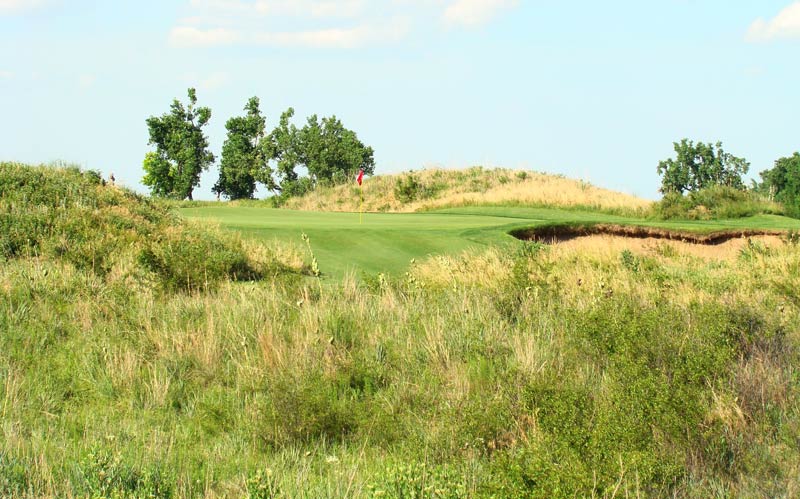
Just having the vision to find this green site through the dunes took great skill and is a sure sign of how much time Perry Maxwell spent on the property getting the routing right. The dune on the left obscures a nasty little bunker. Maxwell considered this his best one shotter and indeed he thought it the best in America.
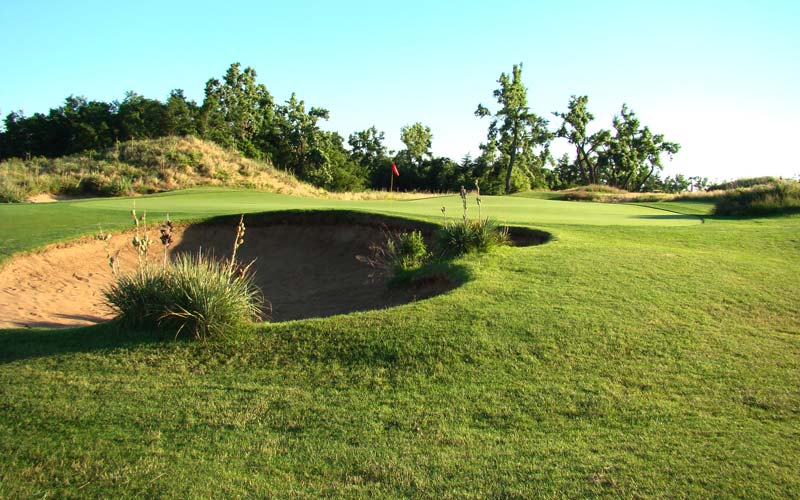
Though not evident even from this close, the tenth putting surface, like several other greens here, falls away at its back which has a depressing way of determining just how well struck a tee ball really was.
Eleventh hole, 450 yards, Honey Locust, (Press); This hole ends one of the toughest four hole stretches in the game and for some, it is their favorite Press hole. In fact, the next six holes are all Press holes and they lead the golfer into a part of the property that has a slightly different look and feel to the front nine with cottonwood trees being more prevalent. The knob in front of the eleventh green is a stroke of design genius and deflects the weakly hit ball to the left or right.
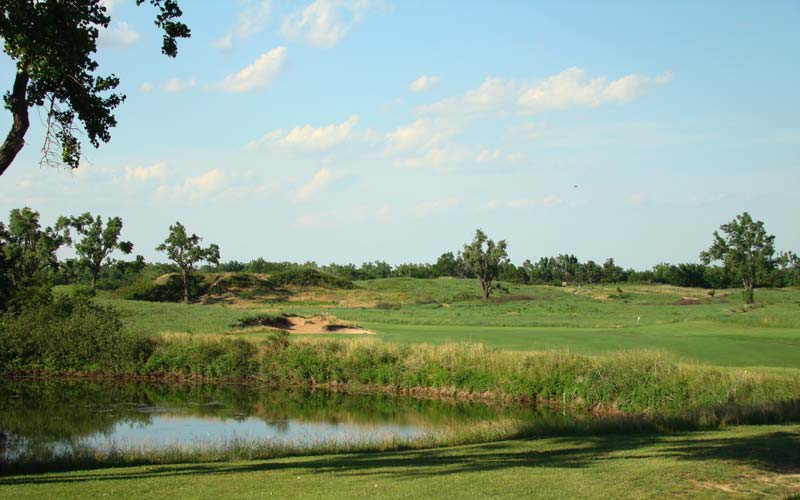
The dogleg left eleventh takes the golfer into a part of the property that has a different look about it.
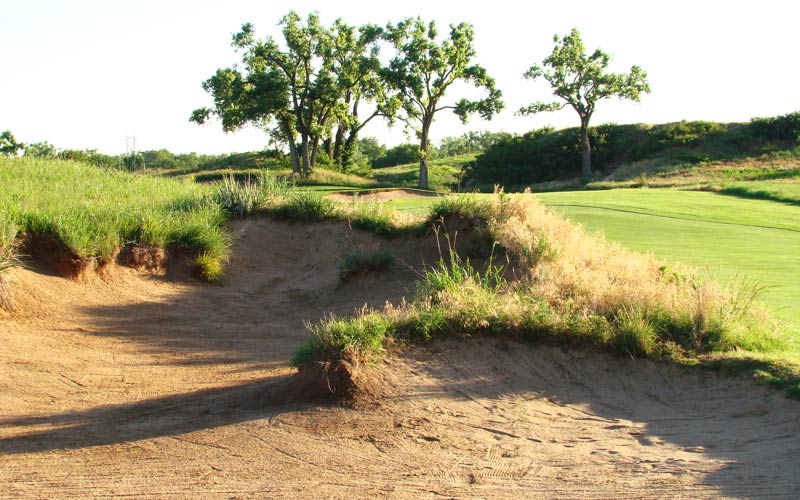
This bunker guards the inside of the dogleg and hides the eleventh green, which is in the direction of the distant trees.
Twelfth hole, 390 yards, Briar Patch, (Press); Similar to the third hole, Doug Petersan relocated the back (and middle) markers to the highest ground on the back nine. The hole is all the better for it with the golfer once again feeling the full brunt of the wind. Two cottonwood trees seventy-five yards forward of the green narrow the approach. Given Ben Crenshaw and Bill Coore’s deep admiration of Prairie Dunes, perhaps they had this hole in mind when they used trees to shape the strategy at such holes as the seventh and twelfth at Cuscowilla. Also, one of the course’s subtler features was recently highlighted here. A player pushed his tee ball to the right and hit a knockdown to stay beneath the branches of the right cottonwood. The ball was well struck but carried too deep into the green and bounded into a back bunker. So what, you may say?Well that bunker is fifteen (!) paces behind the green and was placed there for that very scenario. This is a perfect example of a Green Keeper understanding the design intent of the architect and providing the optimal conditions for the design to shine. Without firm conditions, the back bunker would be just window dressing and Prairie Dunes would be half as much fun to play.

As seen from the tee, the tall cottonwood trees pinch in the approach to the twelfth green.
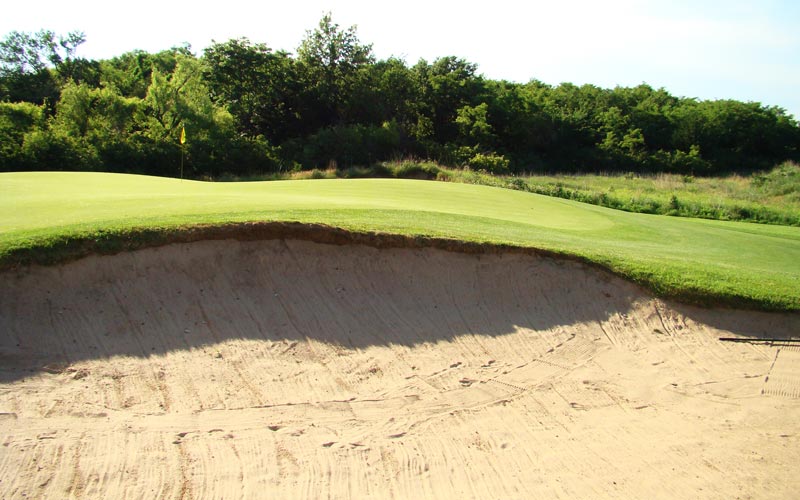
The cottonwoods dominate the conversation when it comes to the twelfth which is a shame as its potato chip style green is one of the very best on the course.
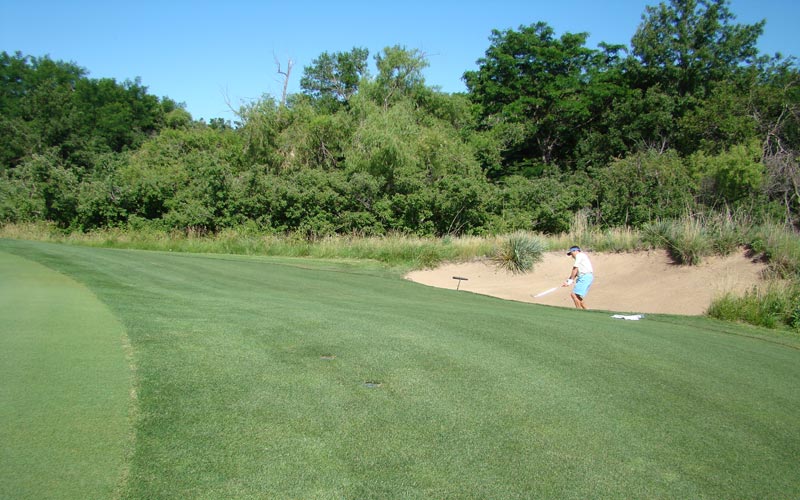
This golfer’s approach just failed to hold the green and finished in the back bunker, courtesy of the firm playing conditions and the tightly mown short grass.
Thirteenth hole, 445 yards, Sumac, (Press); The nasty inside bunker on this dogleg left is both deep and (seemingly) filled with yucca plants. Though not a heavily bunkered course ala an Oakmont, the ones at Prairie Dunes nonetheless fill the tenet of being hazardous with the player needing to avoid them. Once around the bend, the golfer sees another well placed green benched into the hillside. Coore calls the putting surface here ‘absolutely fabulous.’
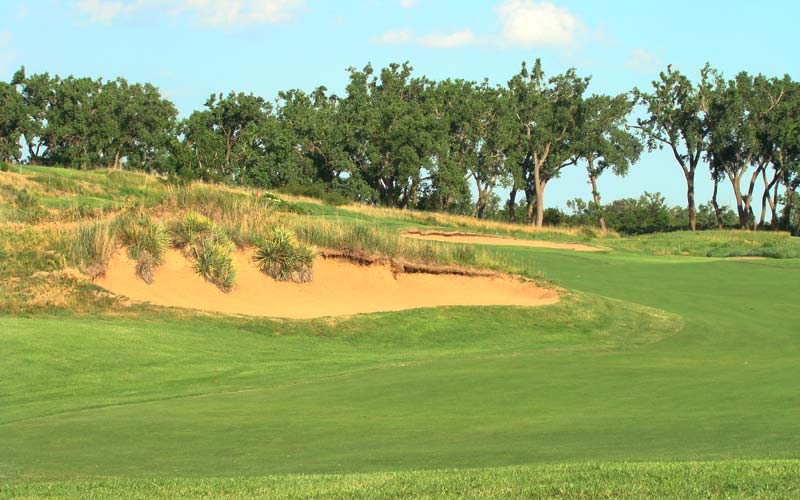
Flirting with this yucca filled bunker on the inside of the dogleg is the ideal play off the thirteenth tee. The area just past the bunker offers the more level stances as opposed to the sloping ground on the outside of the dogleg. The red flag is barely visible over the top of bunker.
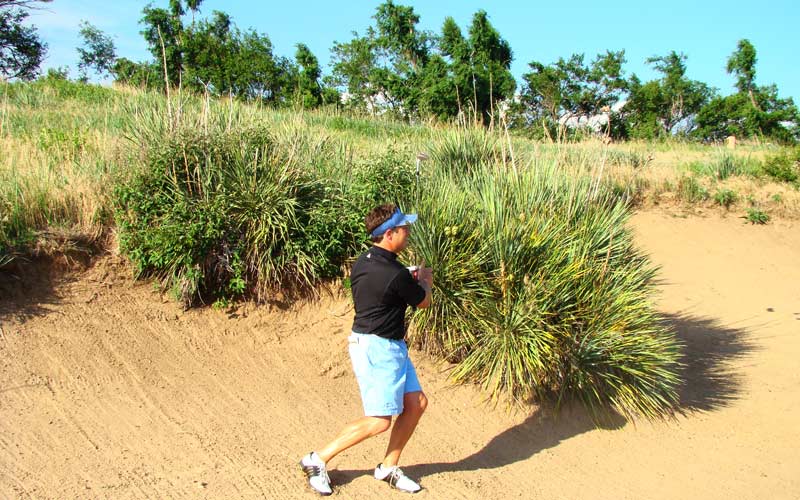
Prairie Dunes features some of the game’s finest hazards with one such example being this greenside bunker at the thirteenth.
Fourteenth hole, 370 yards, Cotton Wood, (Press); A first rate misdirection play with the sight of the flag pulling the golfer ever more to the left, which is where a series of bunkers await. In addition, the green and its slopes best receive a shot from the right center of the fairway. Unlike many modern architects, Press didn’t believe that the golfer had to have perfect visuals of where he was going. In this case, a large hump 130 yards from the green obscures the ideal landing area off the tee.

The sight of the distant yellow flag often lures the golfer into getting too greedy of the fourteenth tee. Better to aim at the bunker on the outside of the dogleg.
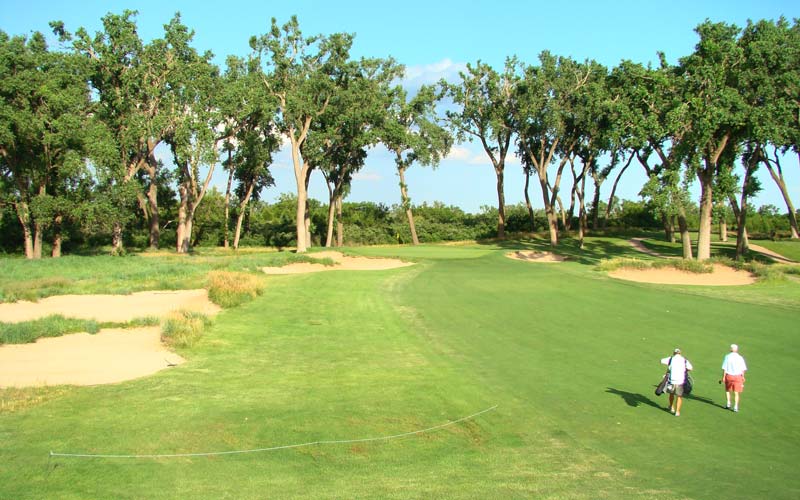
From the 1970s until 2006, the left side of the hole was guarded by one large 130 yard long waste area that was out of character with the rest of the work done by the Maxwell’s. In 2006, Coore & Crenshaw broke up the waste area into several formalized bunkers.
Fifteenth hole, 200 yards, The Chute,(Press); Press’s own comments make it clear that he thought that the cottonwoods added character and thus he was keen to see them incorporated into the design where possible, namely at the twelfth, fourteenth and here. From in a chute of (now) very tall cottonwoods, the golfer is protected from knowing what the wind will do with his tee ball. Coupled with its length, the green is one of the most frequently missed ones and an up and down is anything but ordinary thanks to the green’s high point being near the front center before it falls away toward a lower back right section. At 4,900 square feet, the golfer may consider this green a relatively small target but indeed it is the largest green at Prairie Dunes, where the average green size is under 4,300 square feet. This is another excellent putting surface and Coore marvels at how well Press’s greens tie in with those of his father’s which are considered among the best in the game.
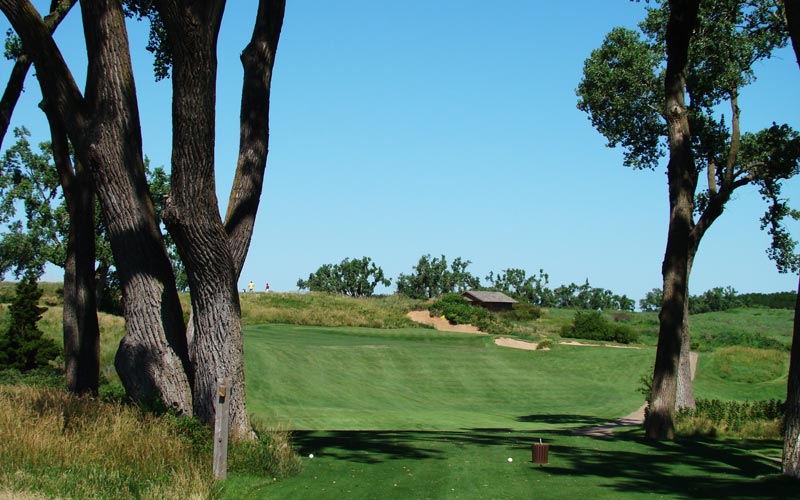
The chute effect from the back markers on the long one shot fifteenth is evident above.
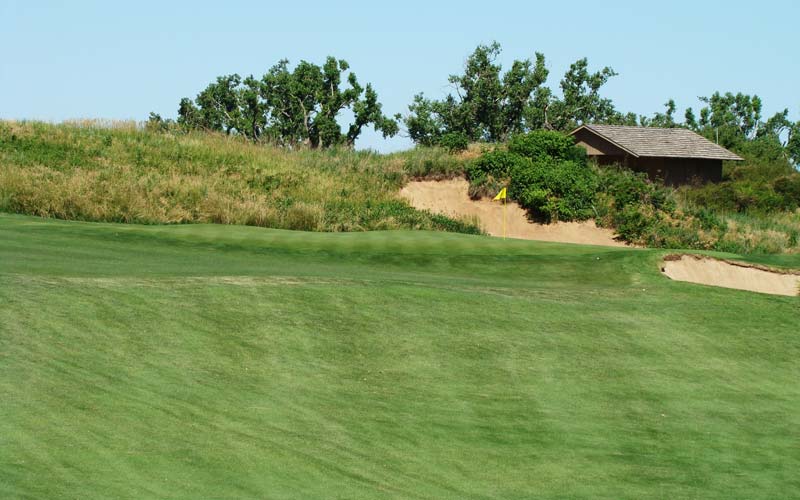
Visually, the fifteenth hole was better tied to the other holes when Dave Axland helped Bill Coore carve out the big sweeping bunker behind the green in 2006.
Sixteenth hole, 415 yards, Blue Stem, (Press); An underrated hole of great merit, the outside of this dogleg is bunkered and guards the ideal line into the green,which angles from front left to back right. Down wind, the golfer may find himself incapable of stopping even a pitching wedge on the putting surface, again highlighting Stan George’s excellent work. Press deserves great credit for getting the ground contours just right at the sixteenth green complex as a low running shot can take the left bank and chase toward the back right hole locations.
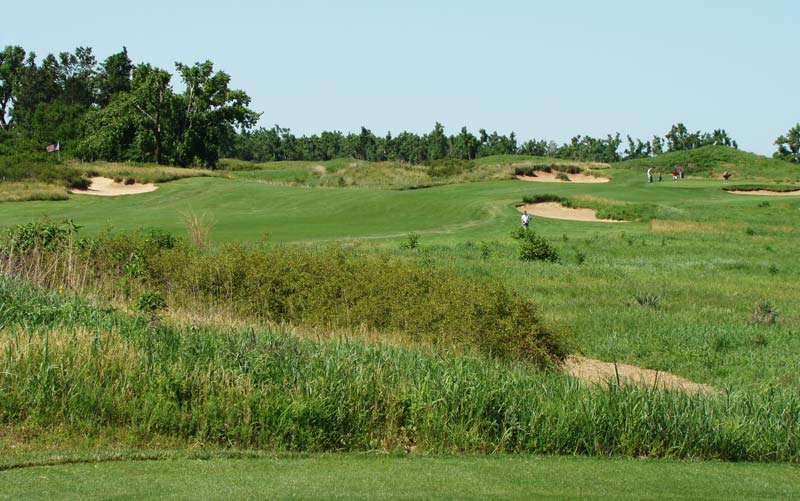
The sixteenth features two fine diagonal angles, one from the tee and one at the green which angles away from front left to back right.
Seventeenth hole, 520 yards, Pheasant Hollow, (Perry); Though this par five is bunkerless save for the one by the green, the location of its green atop a knoll combined with wicked interior green contours is all the defense that this modest length three shooter requires. In fact, P.J. Boatwright told the author in 1985 that this was his favorite green in golf. Rather than slap a second shot somewhere near the green as visitors are prone to do, many members elect to lay back and leave themselves their favorite wedge distance to the green. The two smallest green at Prairie Dunes are at the second hole and here, with each measuring approximately 3,400 square feet. Perry Maxwell stands alone among the other grand master golf architects in his ability to create small targets with severe interior contours that still function well for golf.

The sole bunker on the seventeenth hole is friend to no man.
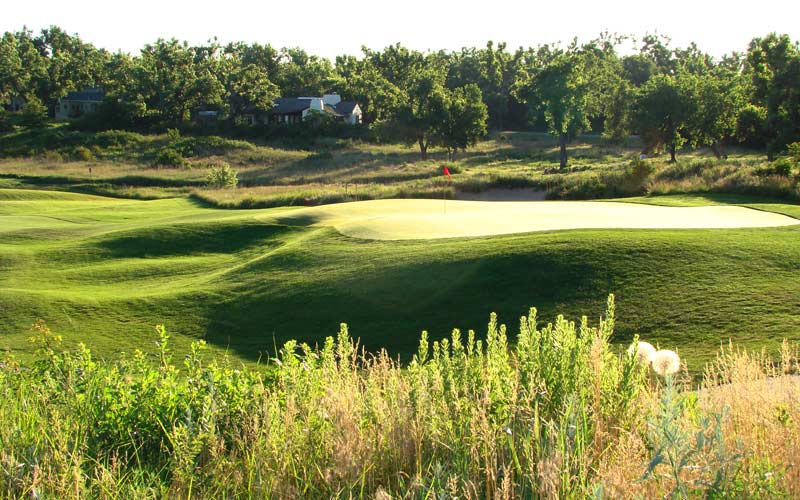
As seen from behind the green, the pinnacle seventeenth green is a tiny target to hit – and hold – from 200 plus yards away.
Eighteenth hole, 390 yards (Perry); The golfer finds himself one last time high on a dune with a rumpled fairway below. The more level lies and the better angle into the green are down the right but that requires the longest and toughest carry from the tee as plum thicket hugs that entire side of the hole. Symbolic of the entire course which measures just over 6,700 yards from the back markers, the eighteenth hole highlights that length isn’t required to make a hole full of challenge and interest.
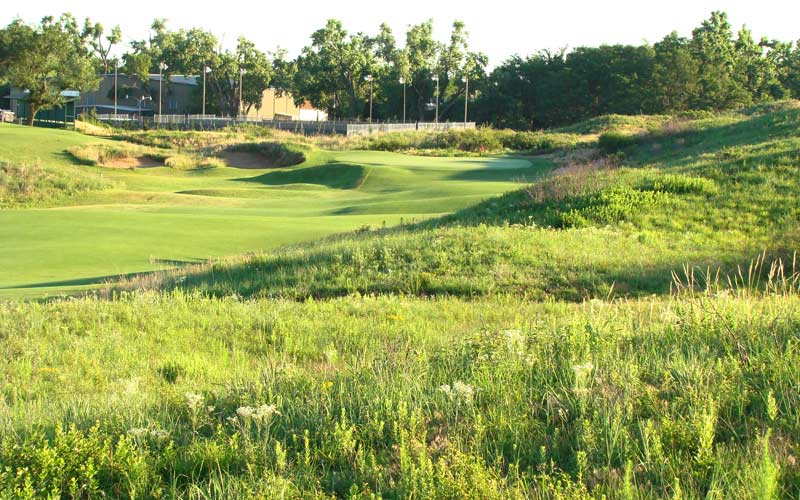
Does one have the nerve to hold a tee ball down the right of the fairway?
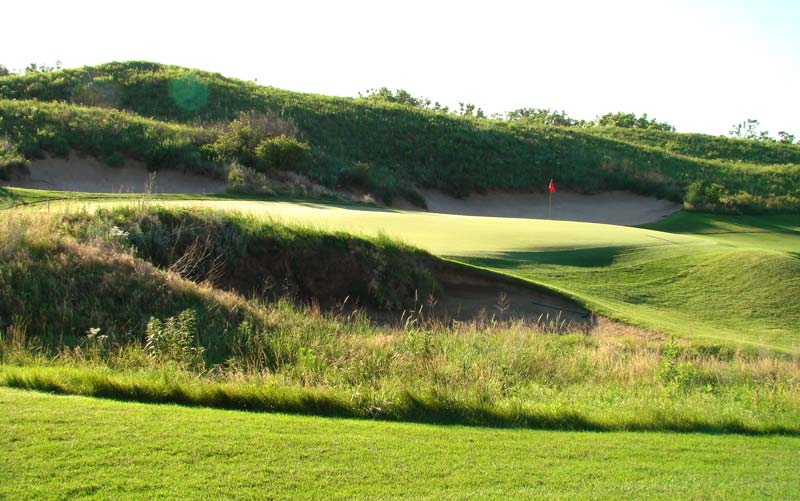
The last view of the course before repairing to the clubhouse is this side one of the eighteenth green complex, which shows how much the green falls away toward the left.
Thus ends the round at Prairie Dunes. While a view of the North Sea never materializes, for many, as at Sand Hills, there is no better course as it possesses the five classic elements required for an ideal course: wind, sand based property with rolling topography, well conceived holes of strategic interest, a predominately treeless environment and uniformly firm playing conditions. Importantly too, it accurately reflects its natural environment and is true to its name: it is a prairie first and foremost thanks in large part to Stan George’s on-going controlled burn policy which allow the prairie grasses to thrive. With 75% of Prairie Dunes’ acreage maintained in its native state, maintenance costs remain reasonable as well, which is another example of Prairie Dunes being true to its Midwest sensibilities.
As one can see, the Maxwells never did anything forced or contrived in building their holes as Prairie Dunes lies peacefully upon the ground. Yet, there is a tremendous amount of architectural integrity found within each hole and it is this combination that makes it the height of great architecture. All in all, it is the ideal course to study to gain a true appreciation for the perfect meld that can occur between nature and the light hand of man.
The End





![The Park, West Palm (Lit 9) [2023]](https://golfclubatlas.com/wp-content/uploads/2024/12/IMG_7092-2-scaled-500x383.jpg)


